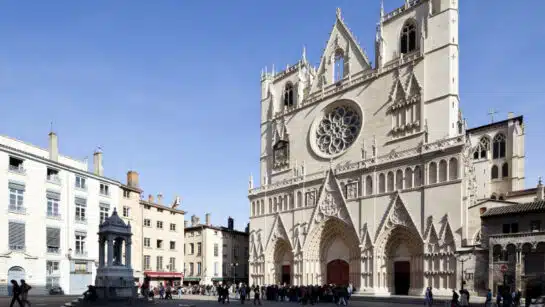Lyon’s mini Eiffel Tower rising higher than the Basilica of Fourvière
The Metallic tower of Fourvière sits at the top of the Montée Nicolas de Lange in the 5th arrondissement of Lyon.

The tower is visible from almost everywhere in the center of the city, especially Place Bellecour. © Jenna Careri
Rising above the spires of the Basilica of Fourvière, the tower is nearly as iconic as the church, lit up in lights every evening. Visible from most points in the city, the structure brings to mind one particularly iconic monument rising above the city of Paris.
Lyon’s “little Eiffel Tower” is a curiosity with seemingly no explanation, privately owned and closed to the public. It currently serves as a radio and television antenna yet was once one of the most popular attractions in Lyon. Where did it come from, why was it built there, and why is it now closed?
Eiffel Tower Fever from Paris to Lyon
Paris’s Eiffel Tower was inaugurated in 1889, during the “Exposition Universelle,” or world fair. Swept up in the glamour of these late 19th century international expositions, some people in Lyon saw an opening to build their own world-class attraction, giving a panoramic view of the city.
The perfect spot was found on a section of the affluent Gay family’s property, which was sold to a private company called the Société Anonyme de la Tour de Fourvière to build Lyon’s very own tower.

View from Tour métallique de Lyon at the beginning of the 20th century. © Archives Municipales de Lyon
Not to be outdone by the religious fervor surrounding the historic basilica, the tower was designed to be the church’s republican, nonreligious counterpart. More importantly, it’s spire would reach higher than those of the basilica, making it the highest point in the city.
Work began in 1893 and the tower was inaugurated during the “Exposition internationale et coloniale” at the Parc de la Tête d’Or. The tower itself is 85 meters high, setting its tip at 372 meters above sea level.
The first name suggested for the new icon was Tour Avellan, after the Russian Admiral Avellan because of the favorable Russian-French relations at the time. However, it was officially named the Tour Paufique, in honor of the project’s head architect.
A Tourist Attraction to Rival All Others
The tower was well and truly based off of its big brother in Paris, with its very own restaurant and observation deck.

Like the basilica, the tower is even visible from outlying districts, like the 9th behind Fourvière hill. © Jenna Careri
Visitors were welcomed into a pavilion on the ground floor, before being ushered into elevators that whisked them into the air. The first stop deposited them at shops and a restaurant run by the Gay family, with panoramic views for their dining pleasure.
But the biggest panorama came on the top floor, 357 meters above sea level, on the observation platform. From their perch in the sky, visitors could see the city from all directions, including the world fair pavilions in the park.
From World Attraction to Radio Tower
The restaurant attracted customers until 1940, when it closed at the start of WWII. Then in 1943, Madame Gay bought the property and the tower back from the Société Anonyme.
During the war, the tower was threatened with destruction and nearly torn down by the Germans, who wanted to use its 2100 tons of metal as a resource. They drew up a plan to dismantle it, but it never went into effect.
The tower officially closed to the public in 1953 and was bought by RTF, the national society of French radio and television, for 15 million francs. Converted into a radio and television antenna, it has remained closed to the public ever since and is impossible to visit.
Today it lights up the sky next to Fourvière every evening, serves as a backdrop for the July 14 fireworks, and provides a funny anecdote for tourists and residents alike as Lyon’s “mini Eiffel Tower.”


